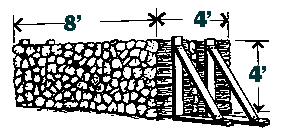TREE TALK
Originally published in Capital on September 15, 2005
A Firewood Primer
The topic of firewood stirs a number of images and thought to people. You tend
to think of the countryside, the outdoors, and camping, crisp fall days. Most
everyone has or feels a connection to the forest when they think of firewood.
The forest is providing a useful and needed product, that doesn’t produce
anxiety over high-energy costs and ruining the environment.
Firewood even if it is a ‘good’ thing, it is basically a
commodity and is analogous to other types of fuel in that we use it to provide
energy, mostly for heat, but people do cook with it. I doubt too many people use
it to boil clothes anymore, electric washing machines being pretty available
these days.
Firewood as a commodity has to be obtained in one of two ways: buying it from
someone else, or gathering it yourself. In this article we’ll discuss buying it.
If you buy it from someone else there are a few things you need to be aware of
if you are going to get the most for your money.
First off, whom you get it from is important. In the state of Maryland, people who sell firewood have to be licensed as a forest products operator to legally sell it. Check the DNR website for additional information.
Firewood in this state must be sold in a standard unit of
measurement called the cord; either as a full cord or as a fraction thereof. You
are not allowed to sell it by the truckload or armload, as there is great
variation in the size of trucks and arms for that matter. If you look at the
wrapping on the bundles of firewood sold at convenience stores you’ll notice
it’ll say 1/128th of a cord. That’s to comply with the letter of the law.
What's in a Cord?
 The
use of the word cord comes from the old practice of measuring a stack of wood
with a cord of such a length that would wrap around a pile of split logs stacked
eight feet long and four feet wide and four feet high.. This means that there
are 128 cubic feet of wood in a cord.
The
use of the word cord comes from the old practice of measuring a stack of wood
with a cord of such a length that would wrap around a pile of split logs stacked
eight feet long and four feet wide and four feet high.. This means that there
are 128 cubic feet of wood in a cord.
Since chunks of firewood are not square but round or irregular, this is not all-solid wood; about 25 cubic feet will be space. Another 10 feet or so will consist of bark, leaving around 90 cubic feet of actual wood in the cord. Which is still a lot of wood. The average cord of hardwood firewood weighs about 5,000 lbs., even with the 25 cubic feet of empty space.
So, if someone sells you a cord of wood and delivers it in the back of the average pickup truck you are getting shorted. A half-cord of wood is all that can be loaded onto a half-ton pickup, unless they don’t mind repairing broken axles. If you buy a cord have them stack it to make sure it measures up.
It would require, taking into account the empty space, about 100 or so bundles of the prepackaged firewood to equal a cord. Do the math on that and you’ll see it’s an expensive way to buy wood. Handy in a pinch, but not a real bargain in the long run.
The type or species of wood making up your cord of
firewood is very important.
Heavier dense woods such as hickory and oak, will produce a lot more energy,
and therefore heat, than lighter woods such as tulip-poplar.
Certain woods are a lot easier to split than others,
too.
Hickory and oak generally split rather easily, as does ash, walnut and maple.
Sweetgum on the other hand, is miserable to try and split and American elm will
wear both you and your axe out.
Click here for a table depicting the properties of the most common species of wood and how they stack up (no pun intended, well maybe) in terms of heat produced , ease of splitting, and even fragrance.
Hopefully, this has provided you enough information to
allow you to purchase firewood in an informed manner. So, happy chopping! Next
time we will look at gathering and harvesting firewood on you own property and
how to do it in a sustainable way.
Questions and comments can be directed to
ForestGreenway@comcast.net
Bud Reaves writes Tree Talk for the Anne Arundel County Forest Conservancy
District Board.
Additional Forestry-Related Links
Champion Trees of Anne Arundel County
Big Tree Champions of Maryland
Native Plants for Anne Arundel County
Planting and Care of Your Trees
TREE-MENDOUS MARYLAND
Invasive Species